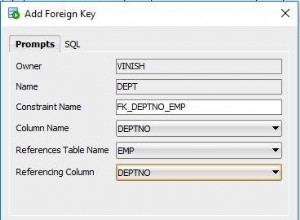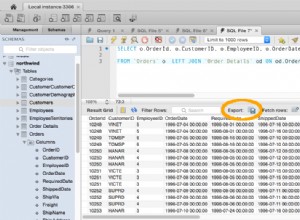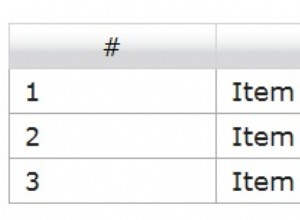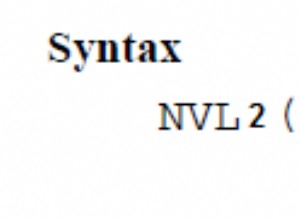Immagino che tu voglia
UPDATE table1 cs
SET cs.abc = (SELECT tc.abc
FROM table2 cgl,
table3 tc
WHERE cgl.prd_id = tc.prd_id
AND cgl.prd_ver = tc.prd_ver
AND cgl.py_id = tc.py_id
AND cgl.typ_id = tc.tpy_id
AND cd.common_column = cgl.common_column)
WHERE EXISTS (SELECT 1
FROM table2 cgl,
table3 tc
WHERE cgl.prd_id = tc.prd_id
AND cgl.prd_ver = tc.prd_ver
AND cgl.py_id = tc.py_id
AND cgl.typ_id = tc.tpy_id
AND cd.common_column = cgl.common_column)
Aggiornamento:oltre alle modifiche alle colonne e ai nomi delle tabelle, la mia risposta iniziale sembra funzionare con i dati di esempio che hai pubblicato. Tieni presente che è sempre più facile pubblicare DDL e DML in modo da poter riprodurre le tue tabelle e i tuoi dati piuttosto che farci convertire i tuoi dati in DDL e DML.
Se creo le tue tabelle e i tuoi dati
SQL> create table table1 (
2 prd_id number,
3 prd_ver number,
4 py_id number,
5 typ_id number,
6 column_used_for_update varchar2(10)
7 );
Table created.
SQL> begin
2 insert into table1 values( 1, 1, 1, 1, 'VALUE1' );
3 insert into table1 values( 2, 3, 4, 5, 'VALUE2' );
4 end;
5 /
PL/SQL procedure successfully completed.
SQL> create table table2 (
2 prd_id number,
3 prd_ver number,
4 py_id number,
5 typ_id number,
6 common_column varchar2(10)
7 );
Table created.
SQL> begin
2 insert into table2 values( 1, 1, 1, 1, 'A' );
3 insert into table2 values( 1, 1, 1, 1, 'B' );
4 insert into table2 values( 2, 3, 4, 5, 'C' );
5 end;
6 /
PL/SQL procedure successfully completed.
SQL> create table table3 (
2 common_column varchar2(10),
3 column_to_update varchar2(10)
4 );
Table created.
SQL> begin
2 insert into table3 values( 'A', null );
3 insert into table3 values( 'B', null );
4 insert into table3 values( 'C', null );
5 end;
6 /
PL/SQL procedure successfully completed.
SQL> commit;
Commit complete.
Quindi regola i nomi delle tabelle e delle colonne dalla mia risposta iniziale, sembra che l'aggiornamento funzioni correttamente
SQL> ed
Wrote file afiedt.buf
1 UPDATE table3 t3
2 SET t3.column_to_update = (
3 SELECT t1.column_used_for_update
4 FROM table2 t2,
5 table1 t1
6 WHERE t1.prd_id = t2.prd_id
7 AND t1.prd_ver = t2.prd_ver
8 AND t1.py_id = t2.py_id
9 AND t1.typ_id = t2.typ_id
10 AND t3.common_column = t2.common_column)
11 WHERE EXISTS ( SELECT 1
12 FROM table2 t2,
13 table1 t1
14 WHERE t1.prd_id = t2.prd_id
15 AND t1.prd_ver = t2.prd_ver
16 AND t1.py_id = t2.py_id
17 AND t1.typ_id = t2.typ_id
18* AND t3.common_column = t2.common_column)
SQL> /
3 rows updated.
SQL> select * from table3;
COMMON_COL COLUMN_TO_
---------- ----------
A VALUE1
B VALUE1
C VALUE2




